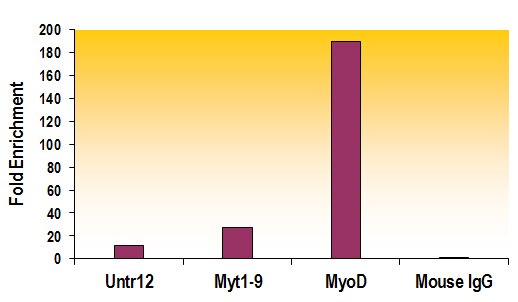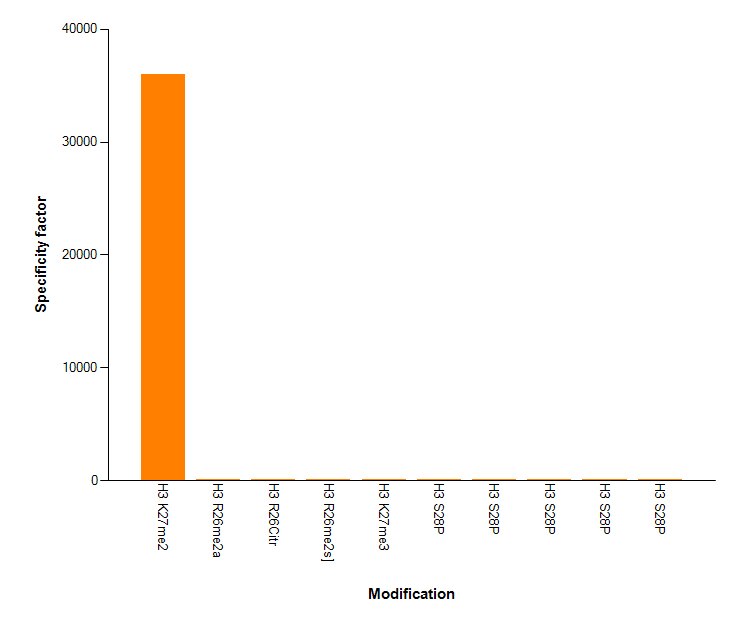Histone H3K27me2 antibody (mAb) (Clone MABI 0324)
Host / Isotype
Mouse / IgG2a
Reactivity
Human, Wide Range Predicted
Applications
ChIP, ChIP-Seq, WB
CloneNo.
MABI 0324
Cat No : 61435 61435
Synonyms
Validation Data Gallery
Product Information
| Tested Applications |
ChIP, ChIP-Seq, WB
Applications Validated by Active Motif: ChIP: 2 ug per ChIP WB*: 0.5 - 2 ug/ml dilution *Note: many chromatin-bound proteins are not soluble in a low salt nuclear extract and fractionate to the pellet. Therefore, we recommend a High Salt / Sonication Protocol when preparing nuclear extracts for Western Blot. |
| Tested Reactivity | Human, Wide Range Predicted |
| Host / Isotype | Mouse / IgG2a |
| Class | Monoclonal |
| Type | Antibody |
| Modification | Methylated |
| Immunogen | This antibody was raised against a synthetic peptide containing dimethyl Lysine 27 of human histone H3. |
| Full Name | Histone H3K27me2 antibody (mAb) (Clone MABI 0324) |
| Synonyms | histone H3, histone, H3, histone-H3, histoneH3, mAb, monoclonal, H3K27me2, Histone H3 dimethyl Lys27, Histone H3 dimethyl Lysine 27, Histone H3 dimethyl Lys 27, Histone H3 dimethyl K27, Histone H3 dimethyl K 27, Histone H3 di-methyl Lys27, antibody, antibodies, chip, chromatin immunoprecipitation, H3K27Me2, polycomb, stem, Clone MABI0324, stem cell, stem cells, immunoprecipitation, ip, immunofluorescence, if, western blotting, wb, antibody, 61436 |
| Molecular weight | 17 kDa |
| GenBank accession number | NP_003522 |
| RRID | AB_2793635 |
| Purification Method | None |
| Buffer | PBS pH 7.5 containing 30% glycerol. 0.3M NaCl, and 0.035% sodium azide. Sodium azide is highly toxic. |
| Storage | Some products may be shipped at room temperature. This will not affect their stability or performance. Avoid repeated freeze/thaw cycles by aliquoting items into single-use fractions for storage at -20°C for up to 2 years. Keep all reagents on ice when not in storage. |
Background Information
Histone H3 is one of the core components of the nucleosome. The nucleosome is the smallest subunit of chromatin and consists of 147 base pairs of DNA wrapped around an octamer of core histone proteins (two each of Histone H2A, Histone H2B, Histone H3 and Histone H4). Histone H1 is a linker histone, present at the interface between the nucleosome core and DNA entry/exit points; it is responsible for establishing higher-order chromatin structure. Chromatin is subject to a variety of chemical modifications, including post-translational modifications of the histone proteins and the methylation of cytosine residues in the DNA. Reported histone modifications include acetylation, methylation, phosphorylation, ubiquitylation, glycosylation, ADP-ribosylation, carbonylation and SUMOylation; they play a major role in regulating gene expression. Histone H3K27 can be mono-, di- or trimethylated by different histone methyltransferases, such as EZH2 or NSD3. While histone methylation can be associated with transcriptional activation or repression, methylation of Lysine 27 of histone H3 is mainly associated with transcriptional repression.



